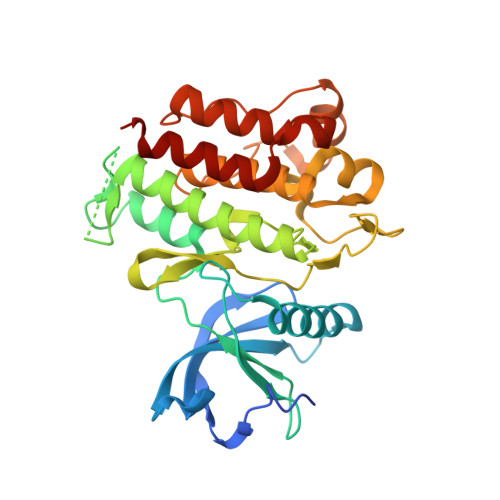Structural basis of resistance of mutant RET protein-tyrosine kinase to its inhibitors nintedanib and vandetanib.
Terzyan, S.S., Shen, T., Liu, X., Huang, Q., Teng, P., Zhou, M., Hilberg, F., Cai, J., Mooers, B.H.M., Wu, J.(2019) J Biological Chem 294: 10428-10437
- PubMed: 31118272
- DOI: https://doi.org/10.1074/jbc.RA119.007682
- Primary Citation of Related Structures:
6NE7, 6NEC, 6NJA - PubMed Abstract:
RET is a transmembrane growth factor receptor. Aberrantly activated RET is found in several types of human cancer and is a target for treating RET aberration-associated cancer. Multiple clinically relevant RET protein-tyrosine kinase inhibitors (TKIs) have been identified, but how TKIs bind to RET is unknown except for vandetanib. Nintedanib is a RET TKI that inhibits the vandetanib-resistant RET(G810A) mutant. Here, we determined the X-ray co-crystal structure of RET kinase domain-nintedanib complex to 1.87 Å resolution and a RET(G810A) kinase domain crystal structure to 1.99 Å resolution. We also identified a vandetanib-resistant RET(L881V) mutation previously found in familial medullary thyroid carcinoma. Drug-sensitivity profiling of RET(L881V) revealed that it remains sensitive to nintedanib. The RET-nintedanib co-crystal structure disclosed that Leu-730 in RET engages in hydrophobic interactions with the piperazine, anilino, and phenyl groups of nintedanib, providing a structural basis for explaining that the p.L730V mutation identified in nine independently isolated cell lines resistant to nintedanib. Comparisons of RET-nintedanib, RET(G810A), and RET-vandetanib crystal structures suggested that the solvent-front Ala-810 makes hydrophobic contacts with a methyl group and aniline in nintedanib and blocks water access to two oxygen atoms of vandetanib, resulting in an energetic penalty for burying polar groups. Of note, even though the p.L881V mutation did not affect sensitivity to nintedanib, RET(L881V) was resistant to nintedanib analogs lacking a phenyl group. These results provide structural insights into resistance of RET mutants against the TKIs nintedanib and vandetanib.
- From the Departments of Biochemistry and Molecular Biology and.
Organizational Affiliation:


















